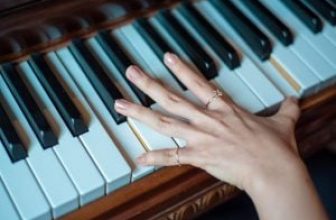
In 2020 almost all of us have adapted faster than we ever thought possible to learning and teaching online. The pandemic year has accelerated our mindsets of how we are capable of learning and teaching and I have to say, personally, I’m amazed at the results.
I went from being a private, face-to-face teacher for 18 years to suddenly teaching via Zoom, Skype, Whatsapp and FaceTime literally overnight. Now almost a year on, I have to say that my students have progressed about the same amount they would have if we had continued face-to-face lessons and I would say that possibly, some of them have actually done better.
So between working with a private teacher, taking a pre-recorded online course, using an app or Youtube videos, what’s the best way to learn the piano online?
Benefits of online lessons with a teacher
Create time to practice
One of the greatest benefits of taking traditional lessons with a private teacher online is that you don’t waste any time traveling to and from lessons. Most of my students average a twenty minute journey each way. After coming to terms with the fact that online lessons were ongoing for a long time, I made a pact with my students that they would spend an extra half hour at the piano after our lesson to practice what we had just been working on.
This is “found time” as normally, they’d be sitting in the car being driven by a parent and any chance of further piano practice that day would be unlikely. By spending that extra time right after the lesson, repeating and reflecting on the techniques and musical phrases we have just worked on, it’s a chance for them to hone their skill and excel to the next point in their learning.
Read music better
One surprising benefit of online learning is that the student is forced to do more of the detective work on a piece of sheet music. I didn’t realize how much I was helping my students to read the notes on the page until I couldn’t do it any more! It was slow going for some of them in the beginning, but they have certainly increased their ability and speed when it comes to reading music.
Work on your own piano
The other positive thing about online lessons is that you get to have your lessons on your own piano. With face-to-face lessons at your teacher’s house, after playing on your own piano all week you have to adjust to your teacher’s piano. It can take several minutes to adjust to how hard you have to press the notes, as well as your ears having to reevaluate what they’re hearing. You might have a digital piano at home and your teacher has an acoustic with quite a heavy touch, meaning you have to press the notes harder. Or maybe your piano is very out of tune and your teacher’s isn’t. These things can throw you off.
Take lessons with a far-away teacher
Teaching the piano online wasn’t new for 2020. There are a great number of teachers all over the world who have been teaching online for years and know that it’s effective and has benefits. If you decide the best way to learn the piano online is to have a private teacher, you can expand your choice of teacher globally. (Although remember time differences!) So another great benefit is that if you live somewhere remote, you can take lessons with a teacher in London, New York, Milan or Paris. The world of piano teachers is your oyster!
How to set-up for online learning
The set-up for both learning and teaching online can be pretty simple. When I teach I just use my phone and when I need to demonstrate I just swing my camera around to show a close-up of my hand on the piano. If I’m playing with two hands I stand my phone up on the end of the keyboard. Some online teachers have secondary cameras over-head giving a bird’s eye view of their piano and it’s easier to see what they’re doing.
As a student, you can stand your phone on the end of your piano, or prop it up away from the piano so your teacher can see your piano keyboard and your hands. If you’re more advanced, place the device further back so your teacher can see your pedalling technique and posture.
Check the lighting to make sure you can be seen. If there’s a window nearby it might throw you into silhouette. Closing the blinds or drapes can solve the problem.
Getting ready for your online lesson
- Make sure the device you’ll be using is fully charged. Set it up in advance if possible. It might take a few minutes of your first online lesson to find the best place, with the help of your teacher.
- Have the music open in the order you’ll be playing them on your music stand so you don’t have to waste time looking for the music during your lesson.
- Arrange to keep children and pets out of the room while you’re having your lesson to minimize distractions.
- For the same reason, turn notifications off on the device you’re using.
- Don’t run washing machines or dishwashers if they’re near where you’ll be having your lesson. The more dedicated focus you have during your lesson, the more effective it will be.
Learning online without a private teacher
Having learned before
If you had some piano lessons when you were a child it might be possible to teach yourself the piano with an App or with the help of a Youtube channel. Depending on how long you took lessons for, it may come back to you quite quickly. It’s a good idea to start from the beginning. Review posture, hand positioning and finger numbers first, then try note reading.
Never having learned before
If you have never had a piano lesson with a teacher, it’s possible you’ll still be able to learn a few songs. However, you’re unlikely to develop good technique and could very easily – and very likely – fall into some bad habits that would stop you from playing fluently or with speed. Bad habits can also cause problems such as RSI (Repetitive Strain Injury) or carpal tunnel syndrome. This would only happen if you spent hours practicing incorrectly, but it’s something to be mindful of. This is a strong reason this is not the best way to learn the piano.
Learning with an App
There are several apps on the market that take you from beginning to an intermediate level. You connect your device to your keyboard and take pre-programmed lessons. Again, you can get started this way but this will also be easier to do if you have a little bit of experience playing.
The downsides
Although these options of learning are enticing because there’s no great financial or time commitments, you might find these benefits are the very things that end up being the drawbacks.
No accountability and no financial investment
If you’re not accountable to anybody for your progress and you have invested an amount that you can easily dismiss, you might not feel very driven to do the work. When you take weekly lessons with a teacher, it urges you to practice because you don’t want to go into your next lesson without having done the practice your teacher asked you to do. Also, you don’t want to feel that you’re wasting your money.
While it might seem better to have no teacher: no stress, no panic – it’s not going to propel you forward. You’ll feel like you have all the time in the world to learn a song, so that’s probably how long it will take you.
No personal feedback
Learning online with an App or Youtube will only take you so far. If you forget your hand position at the piano and spend hours playing in the wrong position, or if you misread some notes and practice the wrong notes for a few weeks, how will you know?
Some apps “listen” to you play and can discern whether the note is right or wrong, but they can’t tell you you’re sitting wrong, that your hand is in a bad position or that you’re using the wrong fingers. They also can’t answer your questions about unfamiliar signs in the sheet music. Without doubt, the best way to learn the piano is to have human feedback.
However, if you like the idea of using an app, one of our favorites is Piano Marvel. It has over 25,000 songs and piano exercises, sight reading training and tests, tracks your progress and gives you instant feedback. It is particularly strong on teaching sight reading as it comes with SASR (Standard Assessment of Sight Reading). You can take the test regularly to see what your score is and see your progress on a chart. Piano players and teachers who make arrangements of well-known songs can upload their arrangements to be used by others.
Online Piano Courses
There are quite a few online piano courses that come as videos or ebooks. More seem to be popping up almost daily. There are a few outstanding courses that are worth considering, including Playground Sessions, Pianoforall and Flowkey.
One of our favorites is Piano Marvel. It has over 25,000 songs and piano exercises, sight reading training and tests, tracks your progress and gives you instant feedback. It is particularly strong on teaching sight reading as it comes with SASR (Standard Assessment of Sight Reading). You can take the test regularly to see what your score is and see your progress on a chart.
So… best way to learn the piano online?
If your goal is simply to play songs for fun, an app or online course will work just fine for you. But if you have larger goals and want to learn with a good technique that will be a life-long skill, consider investing in a good course, a really good app, and at least a few private lessons. The relationship between student and teacher is really important if you want to play to a really high standard. The right teacher will inspire, urge you on and encourage you to do more than you think you can. If you’re using an app, Youtube video or online course, you might feel the lack of that personal feedback and guidance. Although with a course like Piano Marvel you might find that the gap is filled.






